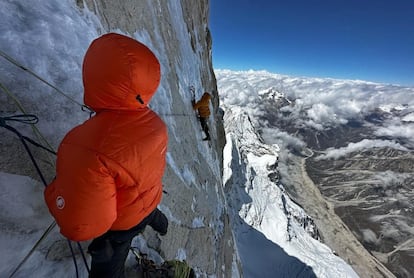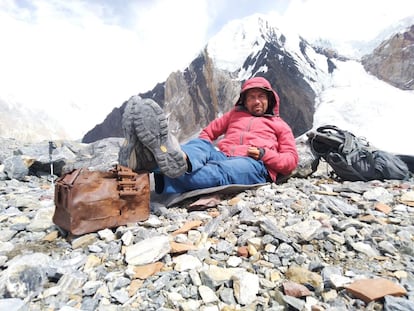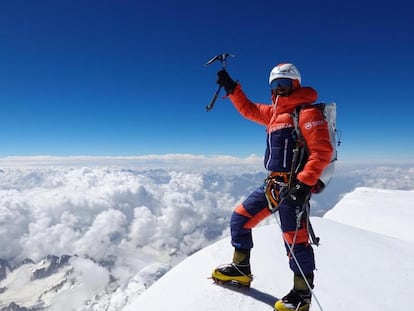A sublime achievement on the north face of Jannu
Three American climbers, Matt Cornell, Alan Rousseau, and Jackson Marwell, conquered the ‘wall of shadows’ in alpine style, considered one of the impossible challenges in avant-garde mountaineering

Jean Ravier, Pyrenean by proximity, mountaineer, and rock artist by the intervention of unknown forces, has missed it... just barely. The twin of Pierre Ravier, who is still alive, passed away just over a year ago at 89, leaving behind an immense legacy of daring new routes on Pyrenean rock faces. But he was not alone. In 1962, Lionel Terray, the man who best defined mountaineers as simply “conquerors of the useless” refused to conquer Jannu (7,710 m, also known as Kumbhakarna) without his help. And together they did it, climbing the southwest ridge. From the top of the mountain, they could feel the cold, the verticality, the disturbing and threatening shadow of its northern slope, a plummet of 2,700 meters. This wall was immediately christened “the wall of shadows,” a symbol of the impossible. Terray and Ravier imagined, perhaps, a future for which no one was yet prepared. Conquering this wall was a futuristic dream. Unimaginable.
A Japanese team managed to overcome it in 1976, but avoided the most direct option and instead chose a line on the far left side of the wall. In 2004, a Russian team won the Piolet d’Or by conquering the very center of the wall, tracing an almost direct line to the summit itself: 10 climbers employed a heavy style, with numerous fixed ropes and material, making good the adage written by Peter Boardman: “If you try hard enough, any mountain can be climbed.” Their Piolet d’Or was criticized because in avant-garde mountaineering, style counts much more than the result: “The Russians have climbed the northern face, a feat of engineering and perseverance, but they have also mutilated it with their heavy style,” Steve House concluded.
A few days ago, three mountaineers who claim to be Americans, but were possibly born Martians, managed to climb the north face of Jannu in alpine style, with less material than the Ravier twins used in their already light Pyrenean adventures. It is one thing to lay siege to a mountain with human and material means, and quite another to do it almost with the clothes on your back, as if you were going for a walk around the block with your dog. The difference, obviously, is the acquired commitment. Jean, if he were still alive, would have been the first to ask the three Americans (Matt Cornell, Alan Rousseau, and Jackson Marwell) how they managed to discover the weaknesses of the wall, to play with its gentle flanks, to negotiate the dead ends, to resist the pressure of the fear of falling, of being trapped, of perishing.
Like the Raviers, the three Americans are ahead of their time, guys who have managed to combine physical strength, unparalleled technical prowess, daring, speed, commitment, and determination to conquer the most iconic wall that avant-garde alpinism had been pursuing for decades. They have also demonstrated patience (it was their third attempt) and a perseverance fueled by dreams of this caliber. “Our hardest steepest climbing was from 7,000 meters to 7,500 meters. This recessed portion of the north face has not been climbed previously. This is where we experienced some of the most intensely wonderful mixed climbing any of us have ever had the pleasure of partaking in,” said Alan Rousseau.
For now, the trio, who spent seven days climbing the mountain and descending, have only published a few written summaries on Instagram, but the images speak for themselves and say everything that words have not yet corroborated: theirs has been a journey that takes your breath away. While they are writing their story, Matt Cornell announced on Monday: “We have immersed ourselves deeply in the confines of what we considered possible and have returned with an experience of enormous significance. Consumed by the obligations of ascension, we lost the meaning of individualism… We still need to reflect in order to offer the appropriate words that evoke this activity.”
Rousseau is a high mountain guide and the element of sanity within the group. Cornell and Marwell are pure inspiration, instinct, mastery, guys who know no fear, who never find compelling excuses to give up. Together, they work like a steamroller. Marwell, a welder by profession, was so unknown until two years ago that his sponsor, The North Face, has not yet filled out his profile on its website. Only his photo appears. Just three years ago, Cornell was a marginal, unknown character, a guy who lived in a hammock in the forest, a character who had the fortune of meeting the great mountaineer Conrad Anker, at that time captain of the North Face’s team of athletes. Then, Cornell fee soloed (without a rope) a mixed route (ice and rock) known as the Nutcracker, opened by Anker himself and which stood out for the poor quality of the rock. In fact, the route features anchors and fixed lines because climbing it without them appeared impossible, unless one had suicidal tendencies. For weeks, Cornell tried the moves alone, cleaned the rock as much as he could, and one day he climbed it alone without telling anyone of his intentions. No one would have believed him if it weren’t for some photos that a hiker took. Pure coincidence. The feat earned him a place on The North Face team and the possibility of changing the hammock for a bed and a roof. His second great moment came in the company of Rousseau and Marwell, in May 2022: the trio climbed the Slovak Direct route to Denali (6,910 m) in 21 and a half hours.
His third masterstroke, on Jannu, places him directly in the golden annals of mountaineering, in what may be a testament to mental strength combined with mastery in the use of ice axes and crampons in terrain where, in alpine style, survival seems like pure chance.
Sign up for our weekly newsletter to get more English-language news coverage from EL PAÍS USA Edition
Tu suscripción se está usando en otro dispositivo
¿Quieres añadir otro usuario a tu suscripción?
Si continúas leyendo en este dispositivo, no se podrá leer en el otro.
FlechaTu suscripción se está usando en otro dispositivo y solo puedes acceder a EL PAÍS desde un dispositivo a la vez.
Si quieres compartir tu cuenta, cambia tu suscripción a la modalidad Premium, así podrás añadir otro usuario. Cada uno accederá con su propia cuenta de email, lo que os permitirá personalizar vuestra experiencia en EL PAÍS.
¿Tienes una suscripción de empresa? Accede aquí para contratar más cuentas.
En el caso de no saber quién está usando tu cuenta, te recomendamos cambiar tu contraseña aquí.
Si decides continuar compartiendo tu cuenta, este mensaje se mostrará en tu dispositivo y en el de la otra persona que está usando tu cuenta de forma indefinida, afectando a tu experiencia de lectura. Puedes consultar aquí los términos y condiciones de la suscripción digital.
More information
Archived In
Últimas noticias
Most viewed
- Reinhard Genzel, Nobel laureate in physics: ‘One-minute videos will never give you the truth’
- Oona Chaplin: ‘I told James Cameron that I was living in a treehouse and starting a permaculture project with a friend’
- Pablo Escobar’s hippos: A serious environmental problem, 40 years on
- Chevy Chase, the beloved comedian who was a monster off camera: ‘Not everyone hated him, just the people who’ve worked with him’
- Why we lost the habit of sleeping in two segments and how that changed our sense of time











































